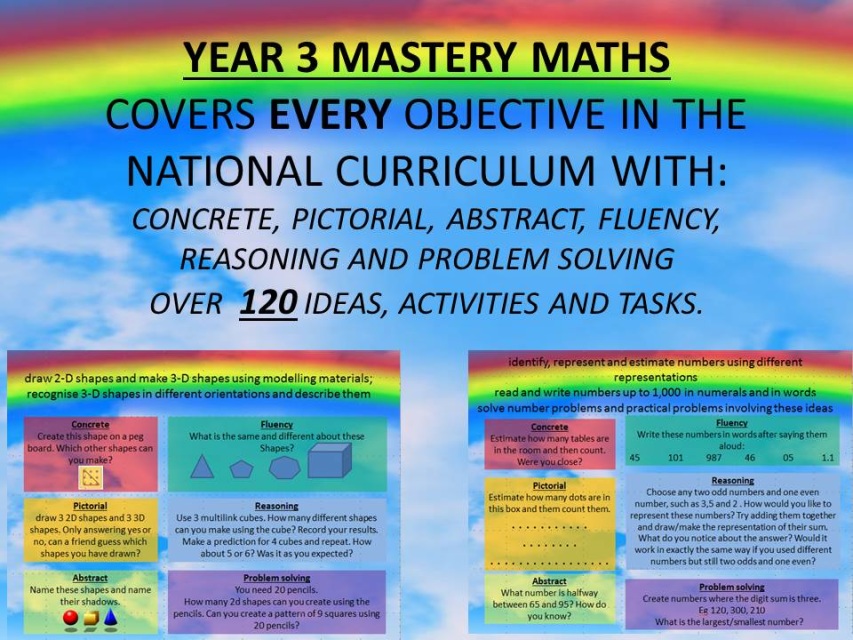YEAR 3 MASTERY MATHS COVERS EVERY OBJECTIVE
SKU:
£5.00
£5.00
Unavailable
per item
YEAR 3 MASTERY MATHS COVERS EVERY OBJECTIVE IN THE NATIONAL CURRICULUM WITH: CONCRETE, PICTORIAL, ABSTRACT, FLUENCY, REASONING AND PROBLEM SOLVING OVER 120 IDEAS, ACTIVITIES AND TASKS.
objectives include:
•count from 0 in multiples of 4, 8, 50 and 100
•find 10 or 100 more or less than a given number
•recognise the place value of each digit in a 3-digit number (100s 10s 1s)
•compare and order numbers up to 1000
•identify represent and estimate numbers using different representations
•read and write numbers up to 1000 in numerals and in words
•solve number problems and practical problems involving place value
•add and subtract numbers mentally including HTU and 1s / HTU and 10s / HTU and 100s
•add and subtract numbers with up to 3 digits using formal written methods of column addition and subtraction
•estimate the answer to a calculation and use inverse operations to check answers
•solve problems including missing number problems using number facts place value and more complex addition and subtraction
•recall and use multiplication and division facts for the 3 4 and 8 times tables
•write and calculate mathematical statements for multiplication and division using the multiplication tables that they know
•count up and down in tenths
•recognise that tenths arise from dividing an object into 10 equal parts and in dividing one-digit numbers or quantities by 10
•recognise find and write fractions of a discrete set of objects: unit fractions and non-unit fractions with small denominators
•recognise and use fractions as numbers: unit fractions and non-unit fractions with small denominators
•recognise and show (using diagrams) equivalent fractions with small denominators
•know the number of seconds in a minute and the number of days in each month year and leap year
•compare durations of events [eg.to calculate the time taken by particular events or tasks]
•draw 2-D shapes and make 3-D shapes using modelling materials; recognise 3-D shapes in different orientations and describe them
•recognise angles as a property of shape or a description of a turn
•identify right angles, recognise that two right angles make a half-turn, three make three quarters of a turn and four a complete turn
PLUS MANY MORE OBJECTIVES!
other year groups available
objectives include:
•count from 0 in multiples of 4, 8, 50 and 100
•find 10 or 100 more or less than a given number
•recognise the place value of each digit in a 3-digit number (100s 10s 1s)
•compare and order numbers up to 1000
•identify represent and estimate numbers using different representations
•read and write numbers up to 1000 in numerals and in words
•solve number problems and practical problems involving place value
•add and subtract numbers mentally including HTU and 1s / HTU and 10s / HTU and 100s
•add and subtract numbers with up to 3 digits using formal written methods of column addition and subtraction
•estimate the answer to a calculation and use inverse operations to check answers
•solve problems including missing number problems using number facts place value and more complex addition and subtraction
•recall and use multiplication and division facts for the 3 4 and 8 times tables
•write and calculate mathematical statements for multiplication and division using the multiplication tables that they know
•count up and down in tenths
•recognise that tenths arise from dividing an object into 10 equal parts and in dividing one-digit numbers or quantities by 10
•recognise find and write fractions of a discrete set of objects: unit fractions and non-unit fractions with small denominators
•recognise and use fractions as numbers: unit fractions and non-unit fractions with small denominators
•recognise and show (using diagrams) equivalent fractions with small denominators
•know the number of seconds in a minute and the number of days in each month year and leap year
•compare durations of events [eg.to calculate the time taken by particular events or tasks]
•draw 2-D shapes and make 3-D shapes using modelling materials; recognise 3-D shapes in different orientations and describe them
•recognise angles as a property of shape or a description of a turn
•identify right angles, recognise that two right angles make a half-turn, three make three quarters of a turn and four a complete turn
PLUS MANY MORE OBJECTIVES!
other year groups available
